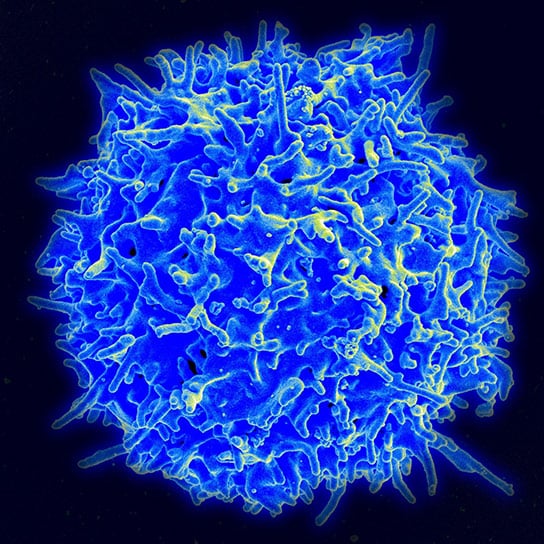
Scanning electron micrograph of a human T lymphocyte (also called a T cell) from the immune system of a healthy donor. Credit: NIAID
Changes in T-cell behavior quickly occur in space, allowing researchers to more effectively study genetic and molecular changes associated with aging-related immune suppression.
Telling someone to “act your age” is another way of asking him or her to behave better. Age, however, does not always bring improvements. Certain cells of the immune system tend to misbehave with age, leaving the elderly more vulnerable to illness. Because these cells are known to misbehave similarly during spaceflight, researchers are studying the effects of microgravity on immune cells to better understand how our immune systems change as we age.
NASA and the National Institute on Aging, part of the National Institutes of Health, have teamed up to support research aboard the International Space Station that may one day advance medical care and quality of life for all humanity. T-Cell Activation in Aging is the first study to launch into space that is funded by the Biomedical Research on the International Space Station National Institutes of Health initiative.
It is difficult to study the genetic and molecular changes associated with aging-related immune suppression because the condition develops over decades, and the elderly often have illnesses that can complicate research studies. However, changes in the immune system—including T-cell behavior—quickly occur in space.
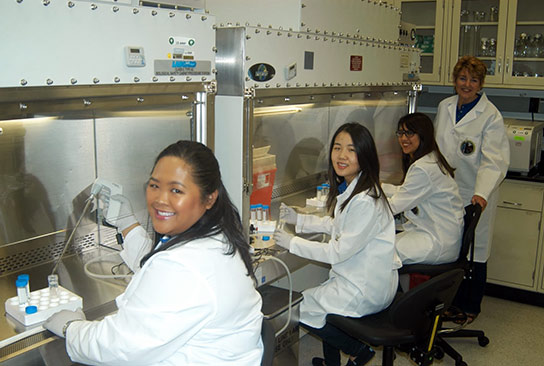
The science team in a laboratory at NASA’s Kennedy Space Center in Florida prepares for launch. From left: Tara Candelario, Miya Yoshida, Emily Martinez, and principal investigator Millie Hughes-Fulford. Credit: NASA / Cory Huston
“One of our goals for this study is to use microgravity as a novel model system of aging to investigate the molecular mechanisms of immune suppression commonly seen in the elderly population,” said Millie Hughes-Fulford, former NASA astronaut, principal investigator for the study and researcher at the University of California, San Francisco, Northern California Institute for Research and Education and the San Francisco Veterans Affairs Medical Center. “Ultimately, this could lead us to new treatment strategies for immune system dysfunction.”
“This experiment’s unique approach to studying molecular mechanisms that contribute to the decline of T-cell function will add to our understanding of the effects of zero gravity on the immune function, as well as provide insights about immune suppression, a major issue affecting older people,” said Felipe Sierra Ph.D., director of the National Institute on Aging Division of Aging Biology. “Hopefully, this will help lead to new interventions to prevent infection not only for those on space travel but also for those with compromised immune systems, including the elderly.”
Our immune systems are sophisticated defense networks for our bodies that protect us from disease. Immune cells constantly patrol our bloodstreams, asking other cells that they encounter—in molecular language—”Are you friend or foe?” When these cells detect an enemy, they deliver that intelligence to a specialized immune cell, known as a T-cell.
“If the immune system is like an army, then the T-cells are the generals,” said Hughes-Fulford.
When news of an enemy encounter is reported to the T-cells, they activate and issue commands to rouse an army of immune cells to fight off the infection. But if the T-cells misbehave and fail to call in the troops, we get sick.
Diminished immune system function is a common problem for the elderly and for astronauts. Remarkably, several key changes in the immune systems of the elderly are the same as those found in astronauts returning from spaceflight. Impaired T-cell activation and rapid cell production are among those changes. Because spaceflight-induced and aging-related immune suppression share these key characteristics, researchers expect results from this study will be relevant for the general population.
Hughes-Fulford’s research seeks to find how exposure to microgravity can mimic aging for immune cells and to reveal the biochemical mechanisms that underlie immune system dysfunction. This knowledge may be applied to develop treatments not only for immune suppression but also for inflammatory diseases in which the immune system misbehaves by overreacting rather than failing to act.
Hughes-Fulford’s most recent spaceflight study—Leukin-2—was designed to identify which aspects of spaceflight disrupt the immune system. Prior research showed that T-cell activation is severely impaired in space. Leukin-2 was the first study to compare T-cell activation in microgravity side-by-side with artificial gravity control samples in a centrifuge aboard the space station. “Our results from the Leukin-2 study demonstrated for the first time that gravity affects gene expression and early activation of T-cells,” said Hughes-Fulford.
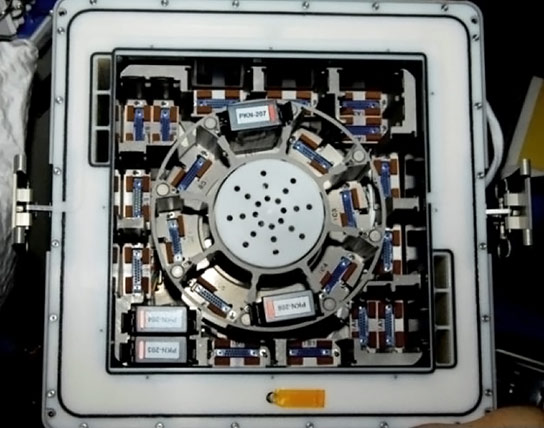
The T-Cell Activation in Aging investigation will use the Kubik incubator aboard the International Space Station. This image shows similar sample units from a previous study called PKinase. Credit: NASA / Millie Hughes-Fulford
On Earth, scientists go to a lot of effort to simulate diseases in the laboratory so they can study them and develop ways to prevent or treat them. After a relatively brief trip to the space station in the Leukin-2 study, unmodified T-cells from healthy donors mimicked T-cells from elderly immunosuppressed individuals. In other words, Hughes-Fulford found that exposure to microgravity can simulate aging.
T-Cell Activation in Aging builds upon the insights gained from the Leukin-2 study by providing new information about the biochemical mechanisms of T-cell activation.
Hughes-Fulford’s science team loaded samples of human T-cells from healthy donors into specialized experiment containers at NASA’s Kennedy Space Center in Florida in preparation of T-Cell Activation in Aging’s launch on April 18. The investigation flew to the station aboard the third commercial resupply mission of SpaceX’s Dragon spacecraft. Space station crew members placed the samples into the Kubik incubator facility in the European Space Agency’s (ESA) Columbus laboratory.
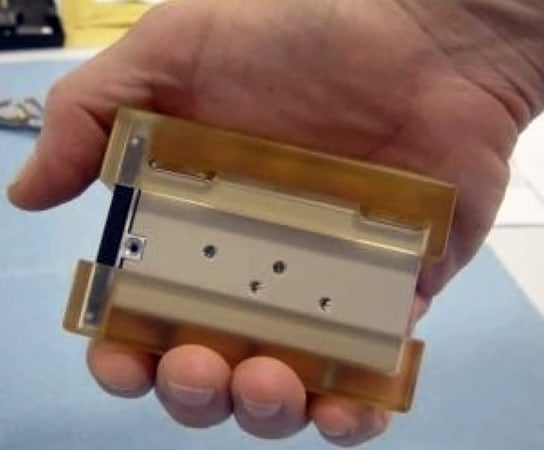
At specified times during the T-Cell Activation in Aging study, the International Space Station’s crew will use hand-operated tools to add activation and fixative materials to experiment units like the one seen here. Credit: Millie Hughes-Fulford
During the study, some samples will be placed in a centrifuge, which can create artificial gravity, and will serve as a control to the microgravity samples. An activator will be added to the experiment containers to signal news of an infection for the T-cells. Subsequently, a fixative that prevents the cells from changing further will stabilize the samples for post-flight analysis. The samples will return to Earth aboard Dragon and be delivered to Hughes-Fulford’s science team approximately 30 days after launch.
The National Institute on Aging is the sponsoring agency for T-Cell Activation in Aging. NASA’s Ames Research Center in Moffett Field, California, is the integration partner providing science team support. ESA is the payload developer and is providing investigation hardware, payload integration and operations support for the mission.
Once the samples return to Earth, the science team will analyze the space-flown and ground-control samples for changes in gene expression and protein synthesis. They also will examine the samples for a type of molecule known as microRNA—a small RNA molecule that affects cellular behavior but does not encode a protein. During the Leukin study, researchers saw gravity-induced changes in at least one type of microRNA. The T-Cell Activation in Aging investigation will enable the team to follow up on these findings. The role that microRNAs play in immune system function—on Earth or in space—is presently unknown.
MicroRNAs are promising candidates for pharmaceutical development as they are known to regulate genes. “One of our research goals is to find and test new pathways for regulation of the immune system involving microRNAs,” said Hughes-Fulford. “Once we pinpoint the right targets, we can develop drugs to turn up the immune response for immunosuppressed patients or turn down the response to alleviate autoimmune or inflammatory disease. The switch goes both ways.”
The researchers will apply their findings from this spaceflight investigation to future ground studies of T-cells from elderly individuals.
Microgravity research can help us study biological processes that naturally happen as we age. As we all are aging, we all stand to benefit from new strategies to keep our immune defense systems behaving at their best. We may not stop the flow of time, but with advances made possible by studies like this, there is hope for extending the time we do have for healthy lives here on Earth.
by Gianine M. Figliozzi
Space Biosciences Division
NASA’s Ames Research Center

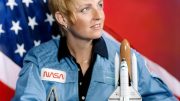
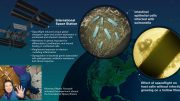
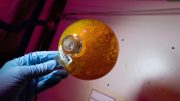
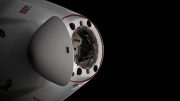
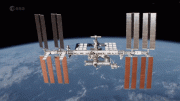
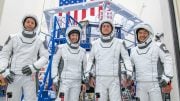

Diminished immune system function is a problem of not only the Aged but also the children. Here, it is found out that micro gravity for the Astronauts also comes into play for reduced immune system function. In children immunity has not grown to the fullest extent and they are very much vulnerable to small infections of cold and diarrhea, whereas in aged the immune system has become worn out and old so that we find many elders suffer from lung infections, pneumonia etc during their fag end of their days. It seems that for Astronauts, micro gravity gives a lead to the immune system as a sort of ‘disease’ as for as the unnatural condition of the person in respect of gravity is concerned. Hence it triggers, micro RNA and brings about sickness of the individuals. Thus micro gravity alone cannot be considered to be a factor for immune suppression but it can complement other factors too. Thank You.